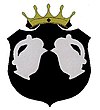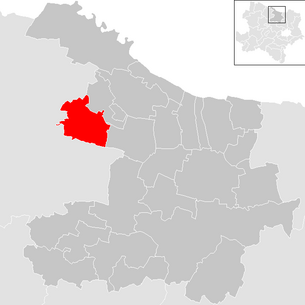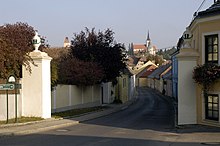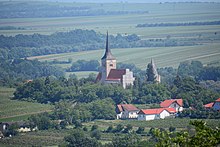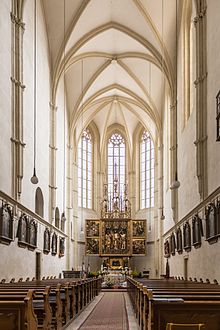Pulkau
|
Borough Pulkau
|
||
|---|---|---|
| coat of arms | Austria map | |
|
|
||
| Basic data | ||
| Country: | Austria | |
| State : | Lower Austria | |
| Political District : | Hollabrunn | |
| License plate : | HL | |
| Surface: | 36.72 km² | |
| Coordinates : | 48 ° 42 ' N , 15 ° 51' E | |
| Height : | 289 m above sea level A. | |
| Residents : | 1,538 (January 1, 2020) | |
| Population density : | 42 inhabitants per km² | |
| Postal code : | 3741 | |
| Area code : | 02946 | |
| Community code : | 3 10 35 | |
| NUTS region | AT125 | |
| UN / LOCODE | AT PKU | |
| Address of the municipal administration: |
Rathausplatz 1 3741 Pulkau |
|
| Website: | ||
| politics | ||
| Mayor : | Leo Ramharter ( ÖVP ) | |
|
Municipal Council : ( 2020 ) (19 members) |
||
| Location of Pulkau in the Hollabrunn district | ||
 Pulkau town hall |
||
| Source: Municipal data from Statistics Austria | ||

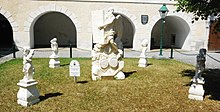
Pulkau is a municipality in the Hollabrunn district in Lower Austria with 1538 inhabitants (as of January 1, 2020).
geography
Pulkau is located in the northern Weinviertel in Lower Austria in the Pulkau valley . The area of the municipality covers 36.72 square kilometers. 25.33 percent of the area is forested.
Community structure
The municipality includes the following six localities (population in brackets as of January 1, 2020):
- Gross-Reipersdorf (155)
- Leodagger (91)
- Passendorf (10)
- Pulkau (1005) including Bründltal and Pulkautal
- Rafing (152)
- Rohrendorf an der Pulkau (125)
The community consists of the cadastral communities Großreipersdorf, Leodagger, Passendorf, Pulkau, Rafing and Rohrendorf.
Neighboring communities
history
The first settlement with Franconian settlers took place under Emperor Charlemagne between 791 and 796 AD. In 1055 the manor was in the hands of the Counts of Hardegg .
The parish was first mentioned in a document in 1080 and viticulture has been officially confirmed since 1216.
In the years in between, construction began on St. Michaelskirche (1155). At this time, the Schottenstift in Vienna also received the right of patronage over the parish.
In 1308 Pulkau received market rights. In 1437 Duke Albrecht V awarded the market seal and coat of arms. From that year until 1790 there was a judge and a market council.
In 1338 a Christian sacristan allegedly helped Jews desecrate a host . As a result, persecution of the Jews broke out in a wide area around Pulkau (see → Pulkau persecutions of 1338 ).
The Gothic branch church Pulkau Heiligblut was built between 1400 and 1422. In 1425 Pulkau - like Schrattenthal and Retz - was devastated by the Hussites .
In 1486 Matthias Corvinus's troops occupied Pulkau - in contrast to neighboring Schrattenthal.
Pulkau was occupied by rebellious farmers in 1597 and the market was occupied again and again during the Thirty Years' War . Under the Swedes in 1645 Pulkau went up in flames.
The plague broke out in Pulkau and the surrounding area. The parish chronicle recorded 600 deaths on December 13, 1680. In order to prevent the disease from spreading, the market was closed.
On January 25, 1712, Emperor Karl VI. Received here by the Lower Austrian estates on his coronation trip to Prague (another stop was Langau in the Horn district ).
In 1724 Abbot Karl Fetzer had the stone Bründl Chapel built, which is still standing today. Thirty years later (1742) the Prussians occupied Pulkau during the Second Silesian War . The French followed them in 1805 and 1809.
The visit to Pulkau by Emperor Franz I and his wife Karoline Auguste on October 8, 1833 was far more peaceful. In 1845 Emperor Ferdinand I and the heir to the throne Franz Joseph were guests.
In 1850 Pulkau also became a community liberated from manorial rule.
Hard times were the First World War and the Second World War with the following ten years of Soviet occupation. One of the most active resistance groups arose in Pulkau in the summer of 1943. Young people, predominantly born in 1927 and 1928, who had their first political formation in the youth organizations “Young Austria” and “Young Fatherland” in the sense of Austrian patriotism, and their group Always faithful to my Austria, they developed a lively anti-Nazi activity. The goals of the young people, who also called themselves Schlurfs , were - according to court rulings - the removal of the mayor and the political leader of the NSDAP in Pulkau and, furthermore, the "violent separation of the Alpine and Donaureichsgaue from the Greater German Reich", i.e. the restoration of Austria. A total of fourteen people were arrested by the Gestapo; Five defendants each were tried by the Higher Regional Court of Vienna and five by the People's Court for preparation for high treason. The only older person involved, Anna Goldsteiner , was sentenced to death and executed on July 5, 1944.
The merger of Großreipersdorf, Passendorf, Pulkau and Rafing to Pulkau took place on January 1st, 1968, the incorporation of Leodagger and Rohrendorf an der Pulka followed on January 1st, 1971.
Much has been done for a new, more modern Pulkau since the end of the 1960s (forest pool, new secondary school, drinking water supply and sewage system with sewage treatment plant). On February 22, 1985 Pulkau was granted city rights.
In 1985 Hermann Maurer organized a Lower Austria conference in Pulkau on behalf of the Society for Prehistory and Early History in cross-border cooperation with the University of Prague. In addition, two conference volumes appeared as scientific publications of the results.
The Pöltingerhof cultural center was opened, the main square and town hall square were redesigned, and the new kindergarten and elementary school followed. In 2000 the Europahaus opened in the rectory, for which the chaplain August Paterno, known from radio and television , was very committed.
Population development

The population has remained almost constant since 1981, as the negative birth balance and the positive migration balance almost canceled each other out .
politics
The municipal council has 19 members.
- With the municipal council elections in Lower Austria in 1990, the municipal council had the following distribution: 14 ÖVP, and 5 SPÖ.
- With the municipal council elections in Lower Austria in 1995, the municipal council had the following distribution: 14 ÖVP, and 5 SPÖ.
- With the municipal council elections in Lower Austria in 2000, the municipal council had the following distribution: 14 ÖVP, 4 SPÖ, and 1 FPÖ.
- With the municipal council elections in Lower Austria in 2005 , the municipal council had the following distribution: 14 ÖVP, and 5 SPÖ.
- With the municipal elections in Lower Austria in 2010 , the municipal council had the following distribution: 14 ÖVP, 4 SPÖ, and 1 FPÖ.
- With the municipal council elections in Lower Austria in 2015 , the municipal council had the following distribution: 14 ÖVP, 4 SPÖ, and 1 FPÖ.
- With the municipal council elections in Lower Austria 2020 , the municipal council has the following distribution: 15 ÖVP and 4 SPÖ.
- mayor
- ? -? Friedrich Kirch
- ? -? Karl Paul
- 1995–2019 Manfred Marihart (ÖVP)
- since 2019 Leo Ramharter (ÖVP)
Culture and sights
- Neudegg ruins
- Pulkau town hall : built in 1659
- Trinity column on the main square
- Pillory on Rathausplatz
- Catholic parish church Pulkau hl. Michael with Karner St. Bartholomew and rectory
- Catholic branch church Pulkau hl. blood
- Maria Bründl Chapel : place of pilgrimage, is a listed building
- Roter Hof : originally the farm and reading courtyard of the Lords of Traun
- Pöltingerhof
- Peschtamühle, Zieglermühle, Hammerschmiede
- Kaiser Franz Joseph Monument
- John Nepomuk statue
- Veronikamarterl
- Court martial
- Lönsstein
Regular events
- Pumpkin festival in the Retz region : the pumpkin festival has been held annually at the end of October since 1993
economy
In 2010 there were 80 agricultural and forestry holdings (there were 167 in 1999), of which 42 were full-time farms. In the production sector, 21 companies employed 97 people, mainly in construction (60) but also in the manufacture of goods (33). The service sector employed 262 people in 83 companies. Around half are employed in social and public services, around a quarter in retail (as of 2011).
traffic
- Railway: The Pulkau Railway on the Zellerndorf – Sigmundsherberg line was discontinued in 1988 for passenger traffic. In 1990 the remaining freight traffic on the section from Zellerndorf to Sigmundsherberg was also discontinued. The train station is around three kilometers outside the city.
- Street: Pulkau lies at the intersection of Pulkautal Straße (B45) and Retzer Straße (B35).
education
In the municipality there is a kindergarten, an elementary school and a new middle school .
health
Several general practitioners and a dentist are available in Pulkau for the health of the population. There is a pharmacy in town.
Others
- In autumn 2009, the Passendorf district became a film set , and director Elisabeth Scharang shot the feature film Maybe in Another Life , based on the play Every His Own by Peter Turrini and Silke Hassler . For this purpose, 100 m³ of gravel was used throughout the village, power lines removed, facades built or restored, and an inn and an old barn built.
Personalities
- Honorary citizen of the community
- Ernest Hauswirth (1818–1901), abbot of the Schottenstift Vienna
- Josef Reither (1880–1950), Austrian politician, governor
- Karl Buresch (1878–1936), lawyer, Austrian politician of the Christian Social Party , governor
- Engelbert Dollfuß (1892–1934), Austrian politician, Federal Chancellor
- Hermann Peichl (1887–1966), Abbot of the Schottenstift Vienna
- Engelbert Heilinger, chronicler and composer
- Year: Rudolf Hirsch (politician) (1903–1984), Austrian politician (ÖVP), Deputy Governor
- Year: Erwin Pröll (* 1946), Austrian politician (ÖVP), Governor of Lower Austria from 1992–2017
- 2005: Chaplain August Paterno (1935–2007), chaplain , author, Austrian television chaplain , founder of the Europahaus in Pulkau
- Year: Friedrich Kirch, master watchmaker, former mayor
- Year: Karl Paul, Former Mayor
- Sons and daughters of the church
- Franz Schneider (organist) (1737–1812), composer, musician, organ virtuoso, organist in Pulkau and later in Melk Abbey
- Peter Tzech , Rector of the University of Vienna, Canon of St. Stephan in Vienna
- Stephanus Schlachter , Rector of the University of Vienna
- Benno Pointner (1722–1807), abbot of the Schottenstift in Vienna
- Walter Ullmann (1910–1983), British historian of Austrian origin
- Herbert Puschnik (* 1944), Austrian local researcher and artist
- People related to the community
- Wolfgang Adam Gotthard, Canon of the Wiener Neustädter Diocese
- Josef Columbus (1804–1877), dean of the theological faculty and head of the castle parish of the imperial court in Vienna
- Franziska Gering (1863–1950), Austrian writer
- Engelbert Heilinger (1876–1961), Austrian chronicler and composer
- Josef Pazelt (1891–1956), author and member of the National Council, taught in Pulkau from 1914 to 1923
- Alois Puschnik (1922–2007), Austrian local researcher (sacred land monuments, family research), lived in Groß-Reipersdorf near Pulkau
- Christian Nebehay (1909–2003), Austrian art dealer, art collector and author
- Renee Nebehay (1916–2004), Austrian author of British origin
- Heinrich Tahedl (1907–1985), Austrian painter and graphic artist, lived from 1969 in the "Kranzlmühle" in Leodagger
- Alois Vogel (1922–2005), Austrian writer, lived in Pulkau from 1976
Web links
- City of Pulkau
- 31035 - Pulkau. Community data, Statistics Austria .
Individual evidence
- ↑ Statistics Austria: Population on January 1st, 2020 by locality (area status on January 1st, 2020) , ( CSV )
- ↑ Friedrich Lotter: Accusation of host sacrilege and falsification of blood miracles in the persecution of the Jews in 1298 ('Rintfleisch') and 1336–1338 ('Armleder'). In: Forgeries in the Middle Ages , Part 5: Fake letters, piety and forgery of realities . Monumenta Germaniae Historica, Volume 33.5, Hannover 1988, pp. 533-583.
- ↑ a b Community changes from 1945 (associations, divisions, name and status changes). Statistics Austria, pp. 30, 57, 163 , accessed on February 11, 2019 .
- ↑ Statistics Austria, A look at the community Pulkau, population development. Retrieved October 8, 2019 .
- ↑ a b Results of the municipal council election 1995 in Pulkau. Office of the Lower Austrian State Government, March 30, 2000, accessed on February 11, 2019 .
- ^ Election result of the municipal council election 2000 in Pulkau. Office of the Lower Austrian State Government, February 4, 2005, accessed on February 11, 2019 .
- ^ Election result of the local council election 2005 in Pulkau. Office of the Lower Austrian State Government, March 4, 2005, accessed on February 11, 2019 .
- ^ Election result of the municipal council election 2010 in Pulkau. Office of the Lower Austrian State Government, October 8, 2010, accessed on February 11, 2019 .
- ^ Election result of the 2015 municipal council election in Pulkau. Office of the Lower Austrian State Government, December 1, 2015, accessed on February 11, 2019 .
- ↑ Results of the municipal council election 2020 in Pulkau. Office of the Lower Austrian State Government, January 26, 2020, accessed on February 24, 2020 .
- ^ Franz Enzmann: Farewell to the mayor with "Rafinger Linsen". In: noen.at . June 27, 2019, accessed August 26, 2019.
- ↑ Statistics Austria, A look at the community Pulkau, agricultural and forestry operations. Retrieved October 8, 2019 .
- ^ Statistics Austria, A look at the community Pulkau, workplaces. Retrieved October 8, 2019 .
- ↑ Statistics Austria, A look at the community Pulkau, employees. Retrieved October 8, 2019 .
- ↑ OpenStreetMap, Pulkau. Retrieved October 8, 2019 .
- ^ Citizens' service, school and kindergarten. City of Pulkau, accessed on October 8, 2019 .
- ↑ Health and Social Affairs. City of Pulkau, accessed on October 8, 2019 .
- ↑ 1st day of shooting in Passendorf. Accessed on November 2, 2009
- ↑ Digitalisat: General Musical Newspaper No. 40, Vienna 1818, Sp 366f...
